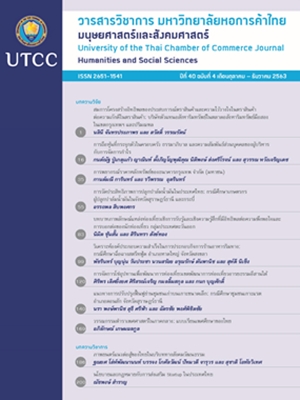The role of cognitive and affective destination image to satisfaction and word-of-mouth among Eastern tourists
Main Article Content
Abstract
Image is an increasingly important are in tourists’ destination. The main purpose of this study is to develop an understanding of cognitive and affective destination image explain with satisfaction and word-of-mouth. Targeting Eastern tourists traveling in Phuket, survey data were collected in 396 completed questionnaires. Structural equation model analysis exposed that five of the six proposed hypotheses were supported from the model. Cognitive destination image had a direct impact on affective image. Both cognitive and affective destination images had positive influences on satisfaction, and in turn, satisfaction predicted word-of-mouth. Moreover, affective destination image had a direct effect on word-of-mouth. Although the cognitive destination image showed no direct association to word-of-mouth, the authors found that it had an indirect effect on word-of-mouth through affective destination image and satisfaction.
Article Details
ลิขสิทธิ์ของบทความ
ผลงานที่ได้รับการตีพิมพ์ถือเป็นลิขสิทธิ์ของมหาวิทยาลัยหอการค้าไทย ห้ามมิให้นำเนื้อหา ทัศนะ หรือข้อคิดเห็นใด ๆ ของผลงานไปทำซ้ำ ดัดแปลง หรือเผยแพร่ ไม่ว่าทั้งหมดหรือบางส่วนโดยไม่ได้รับอนุญาตเป็นลายลักษณ์อักษรจากมหาวิทยาลัยหอการค้าไทยก่อน
References
กรมการท่องเที่ยว. (2563). สถิติการท่องเที่ยว. กรุงเทพมหานคร: ผู้แต่ง.
กระทรวงการท่องเที่ยวและกีฬา. (2560). ยุทธศาสตร์การท่องเที่ยวไทย พ.ศ.2561-2564. กรุงเทพมหานคร: ผู้แต่ง.
คณะกรรมการพัฒนาการท่องเที่ยวประจำเขตพัฒนาการท่องเที่ยวอันดามัน (จังหวัด ภูเก็ต กระบี่ พังงา ตรัง และสตูล). (2559). แผนปฏิบัติการพัฒนาการท่องเที่ยวภายในเขตพัฒนาการท่องเที่ยวอันดามันพ.ศ. 2559 - 2563. กรุงเทพมหานคร: ผู้แต่ง.
Agapito, D., Oom do Valle, P., & da Costa Mendes, J. (2013). The cognitive-affective-conative model of destination image: A confirmatory analysis. Journal of Travel & Tourism Marketing, 30(5), 471-481.
Basaran, U. (2016). Examining the relationships of cognitive, affective, and conative destination image: A research on Safranbolu, Turkey. International Business Research, 9(5), 164-179.
Basaran, U. (2016). Examining the relationships of cognitive, affective, and conative destination image: A research on Safranbolu, Turkey. International Business Research, 9(5), 164-179.
Chiu, W., Zeng, S., & Cheng, P. S. T. (2016). The influence of destination image and tourist satisfaction on tourist loyalty: A case study of Chinese tourists in Korea. International Journal of Culture, Tourism, and Hospitality Research, 10(2), 223-234.
Cohen, S. A., Prayag, G., & Moital, M. (2014). Consumer behaviour in tourism: Concepts, influences and opportunities. Current Issues in Tourism, 17(10), 872-909.
Dedeoglu, B. B. (2019). Shaping tourists' destination quality perception and loyalty through destination country image: The importance of involvement and perceived value. Tourism Management Perspectives, 29, 105-117.
Fornell, C., & Larcker, D. F. (1981). Eveluating structural equation models with unobservable variables and measure. Journal of marketing research, 18(1), 39-50.
Frias, D. M., Rodriguez, M. A., Castaneda, J. A., Sabiote, C. M., & Buhalis, D. (2012). The formation of a tourist destination's image via information sources: The moderating effect of culture. International Journal of Tourism Research, 14(5), 437-450
Gartner, W. C. (1994). Image formation process. Journal of Travel & Tourism Marketing, 2(2-3), 191-216.
Hair, J. F., Anderson, B. W., Babin, B. J., & Anderson, R. E. (2010). Multivariate data analysis with reading (4th ed.). Upper Saddle River, NJ: Prentice-Hall.
Jalilvand, M. R., Samiei, N., Dini, B., & Manzari, P. Y. (2012). Examining the structural relationships of electronic word of mouth, destination image, tourist attitude toward destination and travel intention: An integrated approach. Journal of Destination Marketing & Management, 1(1-2), 134-143.
Kislali, H., Kavaratzis, M., & Saren, M. (2016). Rethinking destination image formation. International Journal of Culture. Tourism and Hospitality Research, 10(1), 70-80.
Kock, F., Josiassen, A., & Assaf, A. G. (2016). Advancing destination image: The destination content model. Annals of Tourism Research, 61, 28-44.
Lv, X., & McCabe, S. (2020). Expanding theory of tourists’ destination loyalty: The role of sensory impressions. Tourism Management, 77. https://doi.org/10.1016/j.tourman.2019.104026
Michael, N., James, R., & Michael, I. (2018). Australia’s cognitive, affective and conative destination image: An Emirati tourist perspective. Journal of Islamic Marketing, 9(1), 36-59.
Prayag, G., & Ryan, C. (2012). Antecedents of tourists’ loyalty to Mauritius: The role and influence of destination image, place attachment, personal involvement, and satisfaction. Journal of travel research, 51(3), 342-356.
Sharma, P., & Nayak, J. K. (2018). Testing the role of tourists' emotional experiences in predicting destination image, satisfaction, and behavioral intentions: A case of wellness tourism. Tourism Management Perspectives, 28, 41-52. doi: 10.1016/j.tmp.2018.07.004
Soonsan, N., & Sukahbot, S. (2019). Testing the role of country and destination image effect on satisfaction and revisit intentions among Western travellers. African Journal of Hospitality, Tourism and Leisure, 8(4), 1-14
Woosnam, K. M., Stylidis, D., & Ivkov, M. (2020). Explaining conative destination image through cognitive and affective destination image and emotional solidarity with residents. Journal of Sustainable Tourism, 28(6), 1-19
Wu, C. W. (2016). Destination loyalty modeling of the global tourism. Journal of business research, 69(6), 2213-2219.
Zhang, H., Fu, X., Cai, L. A., & Lu, L. (2014). Destination image and tourist loyalty: A meta-analysis. Tourism Management, 40, 213-223. https://doi.org/10.1016/j.tourman.2013.06.006


